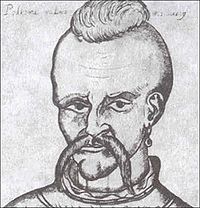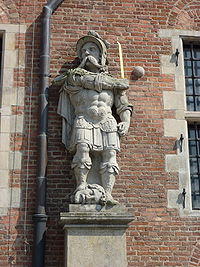
Ioan Potcoava
Encyclopedia



Ukrainian language
Ukrainian is a language of the East Slavic subgroup of the Slavic languages. It is the official state language of Ukraine. Written Ukrainian uses a variant of the Cyrillic alphabet....
; also known as Ioan Sarpega, Ioan Creţul, and allegedly baptized
Baptism
In Christianity, baptism is for the majority the rite of admission , almost invariably with the use of water, into the Christian Church generally and also membership of a particular church tradition...
as Nicoară Potcoavă; died June 16, 1578) was a Hetman of Ukrainian Cossacks
Hetmans of Ukrainian Cossacks
Hetman of Ukrainian Cossacks as a title was not officially recognized internationally until the creation of the Ukrainian Hetmanate. With the creation of Registered Cossacks units their leaders were unofficially referred to as hetmans, however officially the title was known as the "Senior of His...
(1577 - 1578; possibly the first one in history to be elected by the entire Zaporizhian Sich
Zaporizhian Sich
Zaporizhian Sich was socio-political, grassroot, military organization of Ukrainian cossacks placed beyond Dnieper rapids. Sich existed between the 16th and 18th centuries in the region around the today's Kakhovka Reservoir...
), and Voivode (Prince) of Moldavia
Moldavia
Moldavia is a geographic and historical region and former principality in Eastern Europe, corresponding to the territory between the Eastern Carpathians and the Dniester river...
(November - December 1577). His moniker ("potcoavă" in Romanian
Romanian language
Romanian Romanian Romanian (or Daco-Romanian; obsolete spellings Rumanian, Roumanian; self-designation: română, limba română ("the Romanian language") or românește (lit. "in Romanian") is a Romance language spoken by around 24 to 28 million people, primarily in Romania and Moldova...
/"pidkova" in Ukrainian - "horseshoe
Horseshoe
A horseshoe, is a fabricated product, normally made of metal, although sometimes made partially or wholly of modern synthetic materials, designed to protect a horse's hoof from wear and tear. Shoes are attached on the palmar surface of the hooves, usually nailed through the insensitive hoof wall...
") is said to originate in the fact that he used to ride his stallions to the point of breaking off their horseshoes; another version says that he could break and unbend both horseshoes and coins with his fists.
Hetman of the Cossacks
After rising to prominence as a successful soldier, he was elected HetmanHetman
Hetman was the title of the second-highest military commander in 15th- to 18th-century Poland and the Grand Duchy of Lithuania, which together, from 1569 to 1795, comprised the Polish-Lithuanian Commonwealth, or Rzeczpospolita....
by the Cossacks of the Zaporozhian Host
Zaporozhian Host
The Zaporozhian Cossacks or simply Zaporozhians were Ukrainian Cossacks who lived beyond the rapids of the Dnieper river, the land also known as the Great Meadow in Central Ukraine...
neighbouring Moldavia
Moldavia
Moldavia is a geographic and historical region and former principality in Eastern Europe, corresponding to the territory between the Eastern Carpathians and the Dniester river...
. Such elections do not appear to have been uncommon; Stefan Batory
Stefan Batory
Stephen Báthory was a Hungarian noble Prince of Transylvania , then King of Poland and Grand Duke of Lithuania . He was a member of the Somlyó branch of the noble Hungarian Báthory family...
, the Prince of Transylvania
Transylvania
Transylvania is a historical region in the central part of Romania. Bounded on the east and south by the Carpathian mountain range, historical Transylvania extended in the west to the Apuseni Mountains; however, the term sometimes encompasses not only Transylvania proper, but also the historical...
stated that:
- "The lands between the Bug and DniesterDniesterThe Dniester is a river in Eastern Europe. It runs through Ukraine and Moldova and separates most of Moldova's territory from the breakaway de facto state of Transnistria.-Names:...
are populated by a mix of races composed of LithuanianGrand Duchy of LithuaniaThe Grand Duchy of Lithuania was a European state from the 12th /13th century until 1569 and then as a constituent part of Polish-Lithuanian Commonwealth until 1791 when Constitution of May 3, 1791 abolished it in favor of unitary state. It was founded by the Lithuanians, one of the polytheistic...
PolesPolesthumb|right|180px|The state flag of [[Poland]] as used by Polish government and diplomatic authoritiesThe Polish people, or Poles , are a nation indigenous to Poland. They are united by the Polish language, which belongs to the historical Lechitic subgroup of West Slavic languages of Central Europe...
, Muscovites and RomaniansRomaniansThe Romanians are an ethnic group native to Romania, who speak Romanian; they are the majority inhabitants of Romania....
. The Cossacks are raised from the Muscovites and Romanians".
In 1574, Ioan Vodă cel Cumplit
Ioan Voda cel Cumplit
John III the Terrible , also John III the Brave or John III the Armenian was Voivode of Moldavia between February 1572 and June 1574....
named the territory "Our Country from over the Dniester". Other Moldavian Hetmans of the Cossacks were Grigore Lobodă (Hryhoriy Loboda; 1593–1596) and Dănilă Apostol
Danylo Apostol
Danylo Apostol , was a Hetman of the Left-bank Ukraine and Ukrainian Cossack starshina.Born in a noble Cossack family of Moldavian boyar origin, Danylo Apostol was a prominent military leader, polkovnyk of the Myrhorod Regiment, and a participant in the Russian campaigns against the Ottoman...
(Danylo Apostol; 1727–1734).
Voivode of Moldavia
Ioan IV Potcoavă was one of the so called Domnişori ("Little Princes"), named so because of a more or less based claims of belonging to Moldavian ruling families, thus exercising demands of the throne.Claiming to be Ioan III Vodă's half-brother, he chased Petru V Şchiopul from the throne and resisted the first wave of violent Ottoman
Ottoman Empire
The Ottoman EmpireIt was usually referred to as the "Ottoman Empire", the "Turkish Empire", the "Ottoman Caliphate" or more commonly "Turkey" by its contemporaries...
reaction. The Turks, their Wallachia
Wallachia
Wallachia or Walachia is a historical and geographical region of Romania. It is situated north of the Danube and south of the Southern Carpathians...
n vassal
Vassal
A vassal or feudatory is a person who has entered into a mutual obligation to a lord or monarch in the context of the feudal system in medieval Europe. The obligations often included military support and mutual protection, in exchange for certain privileges, usually including the grant of land held...
Mihnea II Turcitul
Mihnea Turcitul
Mihnea II Turcitul was Prince of Walachia between September 1577 and July 1583, and again from April 1585 to May 1591....
and their Polish
Polish-Lithuanian Commonwealth
The Polish–Lithuanian Commonwealth was a dualistic state of Poland and Lithuania ruled by a common monarch. It was the largest and one of the most populous countries of 16th- and 17th‑century Europe with some and a multi-ethnic population of 11 million at its peak in the early 17th century...
partner, King Stefan Báthory, managed to remove him. In the end, Ioan IV Potcoavă was taken prisoner and decapitated
Decapitation
Decapitation is the separation of the head from the body. Beheading typically refers to the act of intentional decapitation, e.g., as a means of murder or execution; it may be accomplished, for example, with an axe, sword, knife, wire, or by other more sophisticated means such as a guillotine...
in Lviv
Lviv
Lviv is a city in western Ukraine. The city is regarded as one of the main cultural centres of today's Ukraine and historically has also been a major Polish and Jewish cultural center, as Poles and Jews were the two main ethnicities of the city until the outbreak of World War II and the following...
.
Legacy
He is the hero of Taras ShevchenkoTaras Shevchenko
Taras Hryhorovych Shevchenko -Life:Born into a serf family of Hryhoriy Ivanovych Shevchenko and Kateryna Yakymivna Shevchenko in the village of Moryntsi, of Kiev Governorate of the Russian Empire Shevchenko was orphaned at the age of eleven...
's romantic
Romanticism
Romanticism was an artistic, literary and intellectual movement that originated in the second half of the 18th century in Europe, and gained strength in reaction to the Industrial Revolution...
1839 poem Ivan Pidkova, of Romania
Romania
Romania is a country located at the crossroads of Central and Southeastern Europe, on the Lower Danube, within and outside the Carpathian arch, bordering on the Black Sea...
n writer Mihail Sadoveanu
Mihail Sadoveanu
Mihail Sadoveanu was a Romanian novelist, short story writer, journalist and political figure, who twice served as acting republican head of state under the communist regime . One of the most prolific Romanian-language writers, he is remembered mostly for his historical and adventure novels, as...
's socialist realist
Socialist realism
Socialist realism is a style of realistic art which was developed in the Soviet Union and became a dominant style in other communist countries. Socialist realism is a teleologically-oriented style having its purpose the furtherance of the goals of socialism and communism...
1952 novel
Novel
A novel is a book of long narrative in literary prose. The genre has historical roots both in the fields of the medieval and early modern romance and in the tradition of the novella. The latter supplied the present generic term in the late 18th century....
Nicoară Potcoavă, and of several Cossack ballad
Ballad
A ballad is a form of verse, often a narrative set to music. Ballads were particularly characteristic of British and Irish popular poetry and song from the later medieval period until the 19th century and used extensively across Europe and later the Americas, Australia and North Africa. Many...
s.

